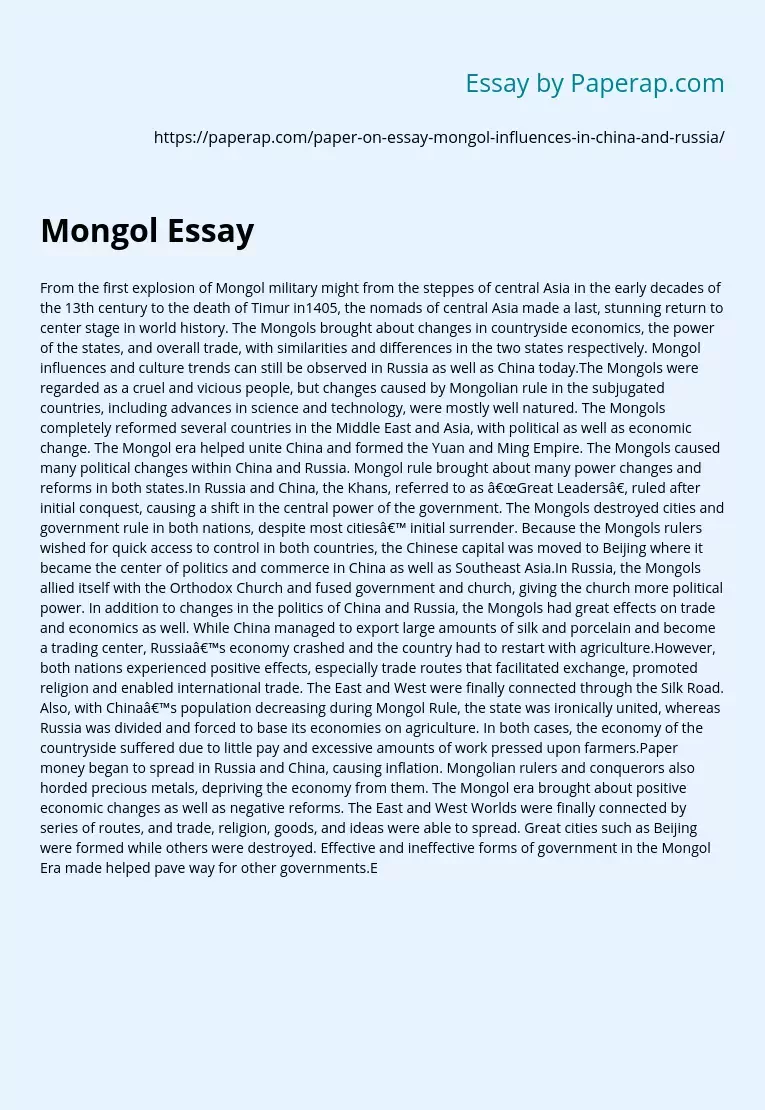Mongol Military Essay
From the first explosion of Mongol military might from the steppes of central Asia in the early decades of the 13th century to the death of Timur in1405, the nomads of central Asia made a last, stunning return to center stage in world history. The Mongols brought about changes in countryside economics, the power of the states, and overall trade, with similarities and differences in the two states respectively. Mongol influences and culture trends can still be observed in Russia as well as China today.
The Mongols were regarded as a cruel and vicious people, but changes caused by Mongolian rule in the subjugated countries, including advances in science and technology, were mostly well natured.
The Mongols completely reformed several countries in the Middle East and Asia, with political as well as economic change. The Mongol era helped unite China and formed the Yuan and Ming Empire. The Mongols caused many political changes within China and Russia. Mongol rule brought about many power changes and reforms in both states.
In Russia and China, the Khans, referred to as “Great Leaders”, ruled after initial conquest, causing a shift in the central power of the government. The Mongols destroyed cities and government rule in both nations, despite most cities’ initial surrender. Because the Mongols rulers wished for quick access to control in both countries, the Chinese capital was moved to Beijing where it became the center of politics and commerce in China as well as Southeast Asia.
In Russia, the Mongols allied itself with the Orthodox Church and fused government and church, giving the church more political power.
In addition to changes in the politics of China and Russia, the Mongols had great effects on trade and economics as well. While China managed to export large amounts of silk and porcelain and become a trading center, Russia’s economy crashed and the country had to restart with agriculture.However, both nations experienced positive effects, especially trade routes that facilitated exchange, promoted religion and enabled international trade. The East and West were finally connected through the Silk Road.
Also, with China’s population decreasing during Mongol Rule, the state was ironically united, whereas Russia was divided and forced to base its economies on agriculture. In both cases, the economy of the countryside suffered due to little pay and excessive amounts of work pressed upon farmers.Paper money began to spread in Russia and China, causing inflation. Mongolian rulers and conquerors also horded precious metals, depriving the economy from them. The Mongol era brought about positive economic changes as well as negative reforms. The East and West Worlds were finally connected by series of routes, and trade, religion, goods, and ideas were able to spread.
Great cities such as Beijing were formed while others were destroyed. Effective and ineffective forms of government in the Mongol Era made helped pave way for other governments.Even though the Mongol Empire collapsed a long time ago, and the Mongolian state is relatively small, Mongolian influences are still effective in Russia and China as well as other parts of the world. With political, economical and religious influences in the once conquered states, the Mongol Era was truly remarkable in its ability to change and reform other countries. Mongol rule could be called either good or bad, but there is no doubt that it has a great effect on us today. This once vast empire has left its mark permanently on the current world as well as the future.
Mongol Military Essay. (2019, Dec 05). Retrieved from https://paperap.com/paper-on-essay-mongol-influences-in-china-and-russia/

